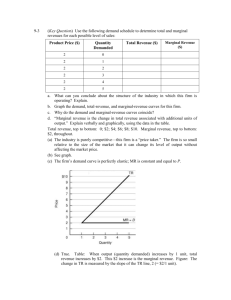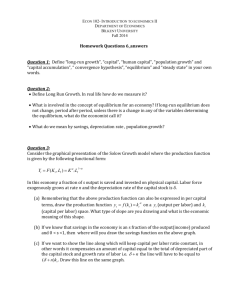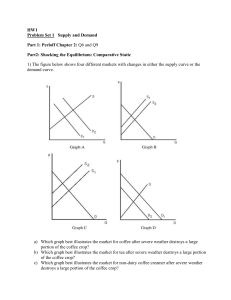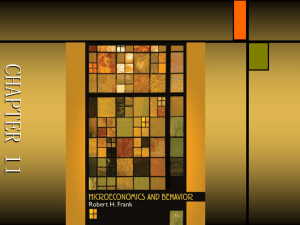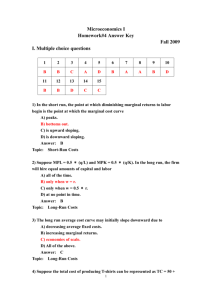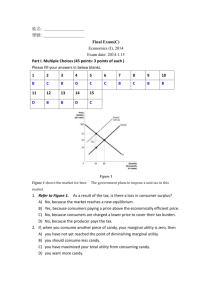Chapter 12. Firms in Perfectly Competitive Markets
advertisement
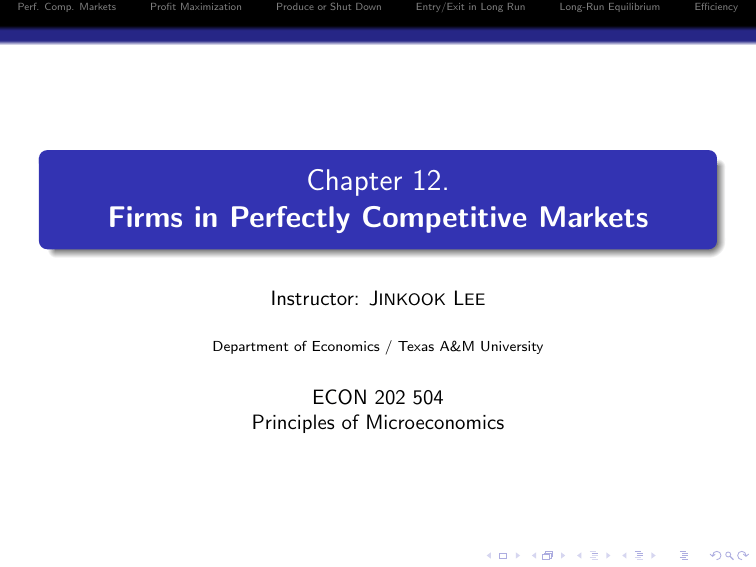
Perf. Comp. Markets Profit Maximization Produce or Shut Down Entry/Exit in Long Run Long-Run Equilibrium Chapter 12. Firms in Perfectly Competitive Markets Instructor: JINKOOK LEE Department of Economics / Texas A&M University ECON 202 504 Principles of Microeconomics Efficiency Perf. Comp. Markets Profit Maximization Produce or Shut Down Entry/Exit in Long Run Breakfast Market Long-Run Equilibrium Efficiency Perf. Comp. Markets Profit Maximization Produce or Shut Down Entry/Exit in Long Run Breakfast Market Long-Run Equilibrium Efficiency Perf. Comp. Markets Profit Maximization Produce or Shut Down Entry/Exit in Long Run Breakfast Market Long-Run Equilibrium Efficiency Perf. Comp. Markets Profit Maximization Produce or Shut Down Entry/Exit in Long Run Breakfast Market Long-Run Equilibrium Efficiency Perf. Comp. Markets Profit Maximization Produce or Shut Down Entry/Exit in Long Run Long-Run Equilibrium Four Market Structures We can divide market structure by three key characteristics. The number of firms in the industry The similarity of the good produced by the firms in the industry The ease with which new firms can enter the industry Four Market Structures Efficiency Perf. Comp. Markets Profit Maximization Produce or Shut Down Entry/Exit in Long Run Long-Run Equilibrium A Perfectly Competitive Markets A perfectly competitive firm cannot affect the market price. prices are determined by the interaction of demand and supply. the actions of any single consumer (or firm) have no effect on the market price. buyers and sellers are Price taker. Why? a firm is very small relative to the market. it is selling exactly the same product as every other firm, thus it can sell as much as it wants without having to lower its price. if a firm raise its price, consumers will switch to buying the product from the firm’s competitors. Efficiency Perf. Comp. Markets Profit Maximization Produce or Shut Down Entry/Exit in Long Run Long-Run Equilibrium Demand Curve for a Perfectly Competitive Firm Demand curve for a firm’s output is a horizontal line. a firm can sell as much as it wants at the current market price but it cannot sell anything at all if it raises the price by even 1 cent. Demand and Supply for Market Demand for a Firm Efficiency Perf. Comp. Markets Profit Maximization Produce or Shut Down Entry/Exit in Long Run Long-Run Equilibrium Efficiency Revenue for a Firm in a perfectly Competitive Market Farmer Parker’s objective is to maximize profit. To do so, he should decide maximizing quantity of wheat. Profit: Total revenue minus total cost (Profit = TR − TC ) Total revenue (TR): total amount a firm receives TR = P × Q Average revenue (AR): Total revenue divided by the quantity of the product sold. AR = TR Q = P×Q Q =P Marginal revenue (MR): The change in total revenue from selling one more unit of a product. MR = ∆TR ∆Q Perf. Comp. Markets Profit Maximization Produce or Shut Down Entry/Exit in Long Run Long-Run Equilibrium Efficiency Revenue for a Firm in a perfectly Competitive Market Farmer Parker’s objective is to maximize profit. To do so, he should decide maximizing quantity of wheat. For a firm in a perfectly competitive market, price is equal to both average revenue and marginal revenue (P = AR = MR). Perf. Comp. Markets Profit Maximization Produce or Shut Down Entry/Exit in Long Run Long-Run Equilibrium The Profit-Maximizing Level of Output Efficiency Perf. Comp. Markets Profit Maximization Produce or Shut Down Entry/Exit in Long Run Long-Run Equilibrium The Profit-Maximizing Level of Output Once more, optimal decisions are made at the margin. The profit-maximizing level of output is where.. the difference between total revenue and total cost is the greatest. marginal revenue equals marginal cost, or MR = MC . For a firm in a perfectly competitive industry, price is equal to marginal revenue (P = MR). we can restate the MR = MC condition as P = MC . Efficiency Perf. Comp. Markets Profit Maximization Produce or Shut Down Entry/Exit in Long Run Long-Run Equilibrium Profit on the Graph Profit can be re-written as follows, Profit = TR − TC = (P × Q) − (ATC × Q) = (P − ATC ) × Q Thus, profit is equal to the quantity (Q) produced multiplied by the difference between price (P) and average total cost (ATC). Efficiency Perf. Comp. Markets Profit Maximization Produce or Shut Down Entry/Exit in Long Run Long-Run Equilibrium Break-even and Loss The optimal condition (MR = MC ) does not guarantee that the firm actually make a profit. 1 2 3 P > ATC : the firm makes a profit P = ATC : the firm breaks even (total revenue=total cost). P < ATC : the firm experiences a loss. in this case, maximizing profit amounts to minimizing loss. Efficiency Perf. Comp. Markets Profit Maximization Produce or Shut Down Entry/Exit in Long Run Long-Run Equilibrium Efficiency Produce or Shut Down in the Short Run Why would a firm continue to produce even though it was operating at a loss? Even if a firm decides to shut down, the firm must still pay its fixed costs. in most cases, fixed costs are sunk costs. Sunk cost: a cost that has already been paid and cannot be recovered. Thus, if the firm can reduce its loss below the amount of its fixed cost, the firm will continue to produce. this happens when total revenue is greater than variable costs. When total revenue is less than variable costs, the firm will shut down. producing would cause it to lose an amount greater than its fixed costs. loss from fixed costs is the maximum the firm will accept. Perf. Comp. Markets Profit Maximization Produce or Shut Down Entry/Exit in Long Run Long-Run Equilibrium Supply Curve of a Firm in the Short Run A firm will produce at the level of output where MR = MC (or P = MC ). that is, the marginal cost curve for a firm tells us how many units of a product the firm is willing to sell at any given price. Thus, a perfectly competitive firm’s marginal cost curve also is its supply curve. But a firm will shut down if its total revenue is less than its variable cost P × Q < VC P < AVC So, the firm’s marginal cost curve is its supply curve only for prices at or above average variable cost. Efficiency Perf. Comp. Markets Profit Maximization Produce or Shut Down Entry/Exit in Long Run Long-Run Equilibrium Efficiency Supply Curve of a Firm in the Short Run Shutdown point: The minimum point on a firm’s average variable cost curve if the price falls below this point, the firm shuts down production in the short run. A Firm’s Short-Run Supply Curve Perf. Comp. Markets Profit Maximization Produce or Shut Down Entry/Exit in Long Run Long-Run Equilibrium Efficiency Market Supply Curve in a Perfectly Competitive Industry We can derive the market supply curve by adding up the quantity that each firm in the market is willing to supply at each price. Individual firm supply Market supply Perf. Comp. Markets Profit Maximization Produce or Shut Down Entry/Exit in Long Run Long-Run Equilibrium Economic Profit and the Entry/Exit Decision Economic profit: A firm’s revenues minus all its costs (implicit and explicit). Farmer Gillette’s Costs (per year) In the long run, unless a firm can cover all its costs, it will shut down and exit the industry. recall that in the long run, there is no fixed cost. Efficiency Perf. Comp. Markets Profit Maximization Produce or Shut Down Entry/Exit in Long Run Long-Run Equilibrium Efficiency Economic Profit Leads to Entry of New Firms Suppose that Farmer Gillette earns an economic profit (S1 , D), and that other farmers are just breaking even by selling their carrots to supermarkets. Farmers will continue entering the market until the market supply curve has shifted from S1 to S2 . Eventually, farmers in the market will return to break even. Perf. Comp. Markets Profit Maximization Produce or Shut Down Entry/Exit in Long Run Long-Run Equilibrium Economic Losses Lead to Exit of Firms Suppose that market demand curve shift to the left, from D1 to D2 . it reduces the market price to $7 per box. Gillette’s demand curve shifts down from MR1 to MR2 at a market price of $7 per box, farmers have economic losses some farmers will exit the market, which shifts the market supply curve to the left. Efficiency Perf. Comp. Markets Profit Maximization Produce or Shut Down Entry/Exit in Long Run Long-Run Equilibrium Efficiency Economic Losses Lead to Exit of Firms Exit continues until the supply curve has shifted from S1 to S2 the market price has risen from $7 back to $10. with the price back at $10, Farmer Gillette will break even. In the new market equilibrium, total sales of carrots in farmers’ markets have fallen from 310,000 to 270,000 boxes. Perf. Comp. Markets Profit Maximization Produce or Shut Down Entry/Exit in Long Run Long-Run Equilibrium Efficiency Long-Run Equilibrium Long-run competitive equilibrium: The situation in which the entry and exit of firms has resulted in the typical firm breaking even. The long-run average cost curve shows the lowest cost at which a firm is able to produce a given quantity of output in the long run. So, we would expect that in the long run, competition drives the market price to the minimum point on the typical firm’s long-run average cost curve. Perf. Comp. Markets Profit Maximization Produce or Shut Down Entry/Exit in Long Run Long-Run Equilibrium The Long-Run Supply Curve Long-run supply curve: A curve that shows the relationship in the long run between market price and the quantity supplied. the long-run supply curve is a horizontal line. Efficiency Perf. Comp. Markets Profit Maximization Produce or Shut Down Entry/Exit in Long Run Long-Run Equilibrium Efficiency Productive Efficiency Productive efficiency: The situation in which a good or service is produced at the lowest possible cost. The forces of competition will drive the market price to the minimum average cost of the typical firm. As we have seen, perfect competition results in productive efficiency. Managers of firms strive to earn an economic profit by reducing costs, but in a perfectly competitive market, other firms quickly copy ways of reducing costs. Therefore, in the long run, only the consumer benefits from cost reductions. Perf. Comp. Markets Profit Maximization Produce or Shut Down Entry/Exit in Long Run Long-Run Equilibrium Efficiency Allocative Efficiency Allocative efficiency: A state of the economy in which production represents consumer preferences; in particular, every good or service is produced up to the point where the last unit provides a marginal benefit to consumers equal to the marginal cost of producing it. Firms will supply all those goods that provide consumers with a marginal benefit at least as great as the marginal cost of producing them because: The price of a good represents the marginal benefit consumers receive from consuming the last unit of the good sold. Perfectly competitive firms produce up to the point where the price of the good equals the marginal cost of producing the last unit. Therefore, firms produce up to the point where the last unit provides a marginal benefit to consumers equal to the marginal cost of producing it.

